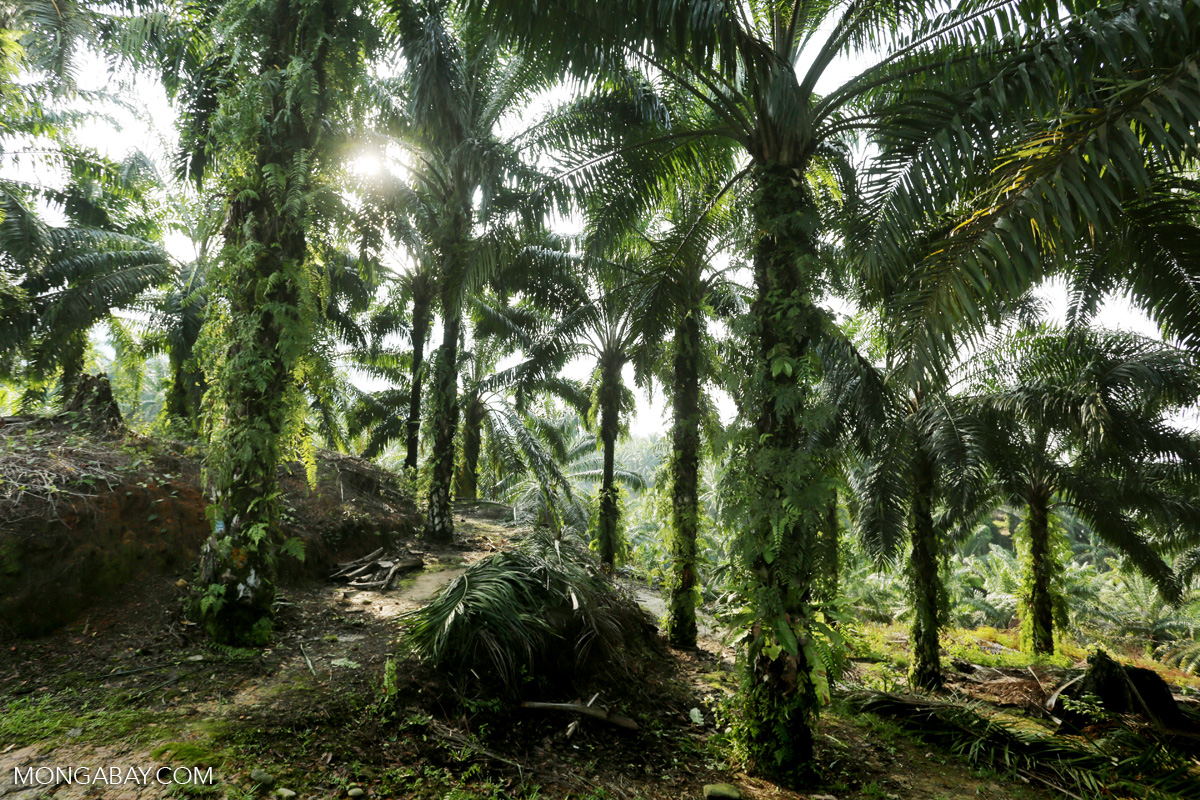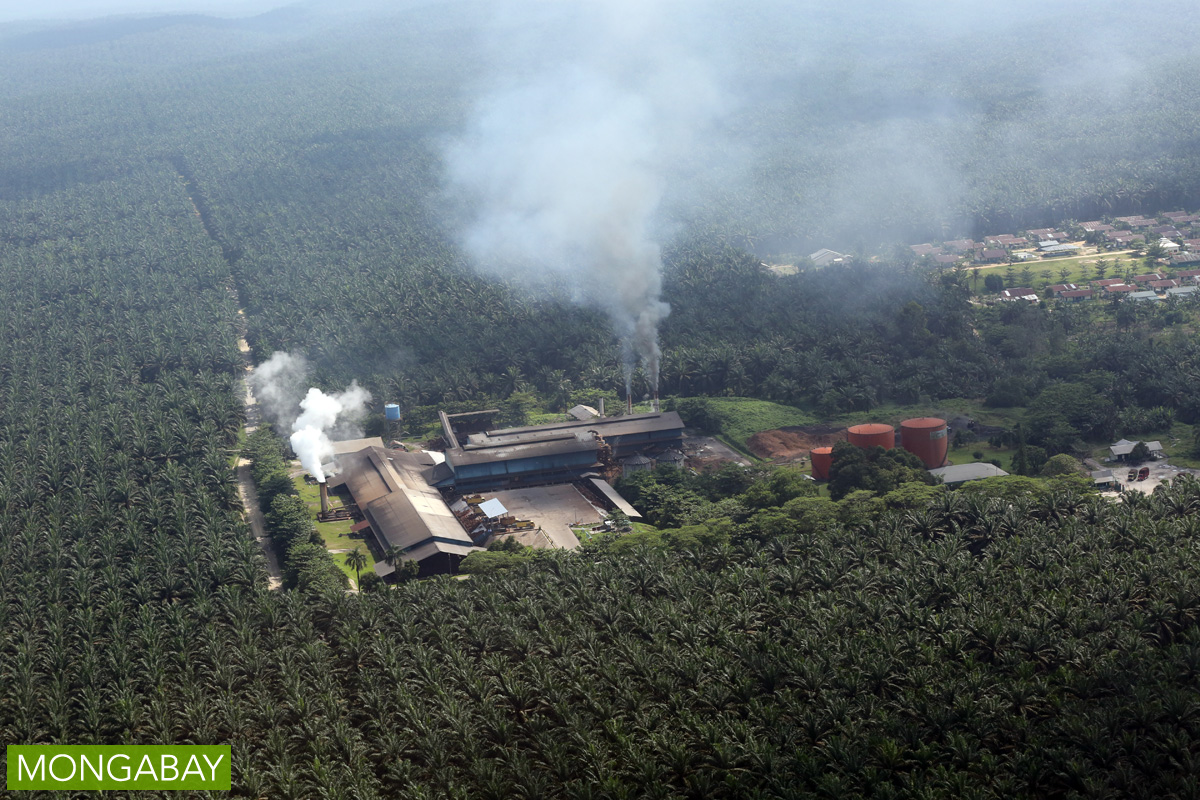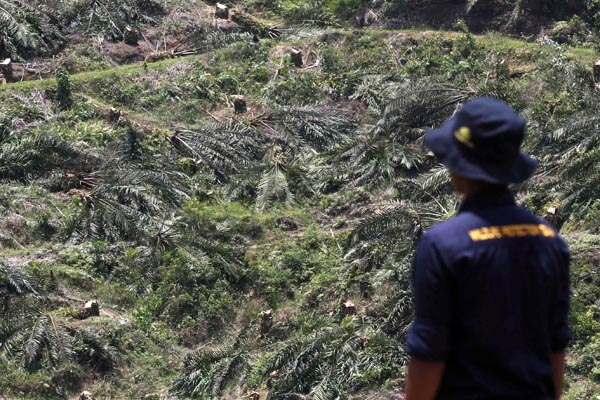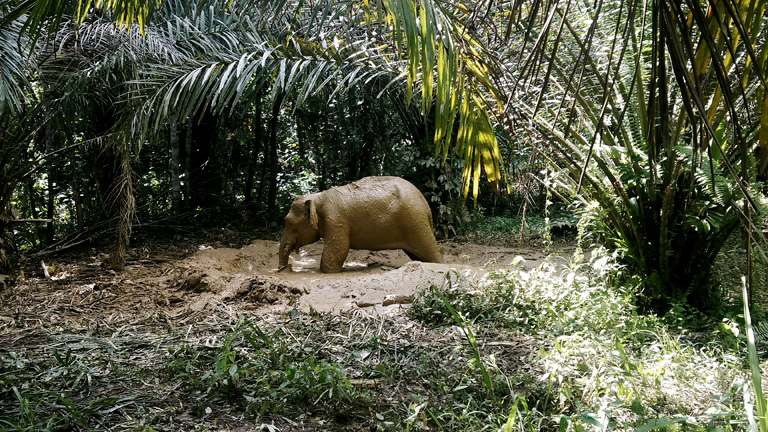- Big companies generally don’t see environmental noncompliance as a major economic risk.
- That’s because they tend to think about their business in the short term, rather than in the long term, where most environmental issues come into play.
- The material impacts of environmentally unsustainable practices can also be hard to quanify.
Part three in a five-part series on the attitudes of palm oil financiers towards company sustainability. Read the first, second, fourth and fifth installments.
The question of materiality — whether an issue affects a company’s finances to a meaningful extent — is key to understanding the drivers behind palm oil finance. Evidence shows that the majority of investors have incentives to evaluate and make investment decisions based on short-term gain. On the other hand, investors do not usually account for losses in value resulting from palm oil companies’ unsustainable practices, because these are both harder to quantify and likely to occur in the longer term.
In its 2012 report, “Palm Oil Investor Review: Investor Guidance on Palm Oil,” the World Wide Fund for Nature (WWF) identified five categories of material risk for oil palm companies with unsustainable practices. Of these, only one category, “Productivity Risks,” is an inherent mechanism, meaning that it does not depend on enforcement by a third party. The report listed the following ways in which poor environmental practices could negatively impact productivity and ultimately revenues:
- Soil erosion, water contamination and failure to maintain site fertility may reduce future yields and returns;
- Planting on peatlands is a high-cost and low-yield practice that may impact margins;
- Failure to maintain biodiversity may eliminate natural pest control animals and increase costs and pollution risks from use of pesticides;
- Loss of natural habitat in and around plantations leads to localized climate differences, in particular a drier microclimate, that may further reduce palm oil yields;
- Suboptimal timing for planting of nursery palms (often planted at three years of age, which is too old) may lead to lower productivity in the early years.[65]
However, experts agree that these risks alone do not create enough of a business case to adopt sustainability.[66] In a 2014 report for the UN Environment Programme’s Inquiry into the Design of a Sustainable Financial System, Ben Caldecott and Jeremy McDaniels of the Stranded Assets Program at Oxford University found “little evidence to suggest that environment-related risks currently pose a systemic risk to the financial system.”[67] Eric Wakker of Aidenvironment Asia concurred, saying that while environmental noncompliance “could certainly hurt” companies materially, they usually do not pose a “massive financial risk.”[68] Benjamin McCarron of Asia Research & Engagement offered a slightly different viewpoint, suggesting that environmental problems may be an indicator of underlying mismanagement, which is likely to have material consequences.[69] Nevertheless, in this case, material impacts would be a consequence of mismanagement issues, rather than the environmental issues themselves.

Researchers believe that increased temperatures[70] and decreased soil moisture levels[71] due to intensifying climate change[72] and the formation of microclimates around large oil palm plantations[73] will eventually have a material impact on yields.[74] Potentially the most material threat to peatland oil palm plantations is flooding. A May 2015 report by Deltares and Wetlands International projected that due to deforestation and peatland draining, soil levels will subside, putting up to 56% of existing peatland plantations at risk of being submerged by floods.[75] Some stranded assets have already been reported in the oil palm industry,[76] such as in Dumai in northern Riau province, where large areas of oil palm plantations have reportedly become flooded and unproductive.[77]
Nevertheless, analyses show that the majority of these environment-related risks become most apparent only in the long term.[78] In the short to medium term, it is doubtful whether these effects will be significantly internalized in companies’ financials, to the extent that they will cause financiers and growers to change their behavior.[79]
Other mechanisms of material risk for oil palm companies
Besides “Productivity Risks,” the WWF report enumerated four other categories of risk through which palm oil companies with poor environmental practices could suffer negative financial consequences. However, almost all of these require enforcement by an external party. Under the category of “Compliance Risks,” violating environmental regulations could lead to fines and the suspension of the plantation owner’s license to operate.[80] However, this is dependent on the monitoring and audit systems of regulatory bodies like the Roundtable on Sustainable Palm Oil and the judicial system of the Indonesian government, both of which have had their reliability called into question.[81] [82]

Under “Reputational Risks,” unsustainable practices may damage the reputation of plantation companies, as well as that of their trading partners, decreasing the willingness of other companies to work with them. In addition, consumer backlash against environmental violations may lead to boycotts and reduced sales, and negative media attention may cause erosion in brand value.[83] This mechanism depends on the work of whistleblowers and activist NGOs to uncover unsustainable practices and spread awareness of them among the public.
Among “Market Risks,” the most significant is probably the recent adoption of “No Deforestation, No Peat, No Exploitation” policies by major palm oil traders such as Wilmar, Musim Mas and Golden-Agri Resources. As these traders cover approximately 85% of the global palm oil trade,[84] growers who do not change their practices risk being cut out of the supply chain.[85] However, this mechanism is dependent on enforcement and monitoring by actors external to the grower itself.
Another market risk is that environmentally minded financiers may deny growers capital through negative screening and divestment, leading to downward pressure on share prices and an inability to finance expansion.[86] However, this relies on the uniform implementation of effective environmental, social and governance (ESG) risk assessments by all possible creditors, a process that faces numerous hurdles, as enumerated in part two of this series. Finally, the demand for the RSPO’s certified sustainable palm oil (CSPO) may grow, causing unsustainable palm oil growers to become unable to find markets and international trading partners.[87] This scenario seems unlikely in the near future: currently, the global supply of CSPO far exceeds demand, and only about 50% of the certified commodity is able to find buyers.[88]
Under “Social Risks,” conflicts with laborers and local communities may lead to industrial stoppages and operating losses.[89] On the other hand, many laborers are migrant workers and child laborers with few legal rights,[90] [91] and in Indonesia, legislation governing the rights of indigenous communities remains weak.[92] Palm oil companies are known to suppress worker disobedience through violence and the termination of workers’ employment.[93] [94] With this unequal balance of power, local communities may find it difficult to stand up to abusive companies; in addition, losses incurred as a result of these conflicts are rarely identified as such on the company’s corporate group level.[95]
The crucial role of regulation and government
From the above analysis, it seems clear that the threat of reduced productivity at some point in the future is not enough to reduce the value of unsustainable companies in investors’ eyes. Hence, governments and regulatory bodies such as the RSPO play a crucial role in getting companies to internalize the negative impacts of their unsustainable activities.

Some experts believe regulators have yet to exercise this role to its full potential. “The RSPO could claim ‘compensation debt’ valued at millions of dollars from companies for clearing land prior to completing appropriate HCV [high conservation value] assessments,” Wakker said. “Instead, it appears to go easy on growers [who violate RSPO standards].” Though the RSPO does suspend companies for failing to submit annual sustainability progress reports,[96] “if a company clears or otherwise loses HCV areas, RSPO does not have clear rules on what is supposed to happen next.”[97]
The increasing trend towards government regulation – and the difficulty of legal sanction
Until recently, few countries had legislation regulating what financial institutions, investors and other companies in the palm oil supply chain could or could not do. In the Southeast Asian palm oil sector, “there has been no real legal system or precedent for taking action against those who do the wrong thing, such as employing slave, forced, and child labor,” said Gabriel Thoumi, sustainability analyst and faculty at the University of Maryland’s Robert H. Smith School of Business.[98]
With a lack of legal oversight, quantifying material risk becomes even more complicated. Recognizing the problem, Indonesia has adopted a roadmap to eliminate child labor by 2022, but enforcing this will be difficult because of insufficient manpower and public data on labor violations.[99] “Without improved disclosure, it is hard to tell if regional banks are actually making money from oil palm deals that employ such labor,” Thoumi added. “It is possible that they are losing money on the deals themselves, but growing fees from the overall partnership.”[100]

The first governmental attempts to regulate sustainable palm oil came from consumer countries downstream in the supply chain. In 2010, the Netherlands launched the Dutch Task Force for Sustainable Palm Oil, which mandated that only sustainable palm oil could be purchased for the Dutch market by end 2015. As a result, the percentage of CSPO used in the Netherlands jumped from 30% in 2011 to 72% in 2014.[101] Other European countries, including Belgium,[102] France,[103] Germany[104] and the UK,[105] have responded by issuing mandates with similar timelines.
More recently, countries that play key roles in palm oil financing have taken steps to tighten regulations. In 2014, Singapore passed its Transboundary Haze Pollution Act, which allowed entities causing haze pollution in Singapore to be taken to court, regardless of whether they were based in Singapore or not.[106] The act was followed up by the Association of Banks in Singapore’s Guidelines on Responsible Financing in October 2015, which mandated stricter disclosure, governance and capacity building with regard to ESG issues for the majority of banks in the city-state.[107] Japan’s “Corporate Governance Code,” introduced in March 2015, provides a voluntary governance framework that may make it harder for Japanese financiers to invest in unsustainable palm oil.[108] Most notably, in October 2015, the China Chamber of Commerce of Foodstuffs and Native Produce also presented its Guide for Overseas Investment and Production of Sustainable Palm Oil by Chinese Enterprises. These guidelines are still in the process of being finalized, but if successfully implemented, China’s commitment will play a big role in turning the tide toward sustainable palm oil: China is one of the world’s largest purchasers of palm oil, accounting for 12% of the global market.[109]

The Indonesian government has lagged in enforcing sustainability policy, but the severity of recent fires has triggered some changes. In September 2014, Indonesia finally became the last country to ratify the ASEAN Agreement on Transboundary Haze Pollution, binding the government to take measures to prevent and monitor the spread of haze across borders.[110] In November 2015, President Joko “Jokowi” Widodo’s administration instructed companies to refrain from clearing peatlands in existing concessions and planting areas that burned.[111] A legally binding presidential decree on the matter is said to be forthcoming. Most recently, in January, Jokowi made good on his promise to establish a peatland restoration agency, which aims to restore 2 million hectares of degraded peat within the next five years. [112]
The Indonesian environment ministry is currently investigating 276 companies for their role in 2015’s fires; of these, 23 have been served with sanctions ranging from increased supervision to a permanent suspension of their licenses to operate.[113] In September 2015, the Supreme Court ordered PT Kallista Alam to pay a record $26 million in fines and reparations for clearing land with fire in Aceh’s Leuser Ecosystem, but in December a South Sumatra court threw out a similar case brought by the government against pulp and paper supplier PT Bumi Mekar Hijau.[114] The environment minister, Siti Nurbaya, has vowed to personally oversee the government’s appeal.[115] Historically, few companies have been successfully prosecuted for their role in causing fires and haze.[116] It remains to be seen whether the latest efforts will garner different results.
Citations:
[65] Palm Oil Investor Review, p11.
[66] Cary Krosinsky (personal communication, July 30, 2015).
[67] Ben Caldecott and Jeremy McDaniels, “Financial Dynamics of the Environment,” p6.
[68] Eric Wakker (personal communication, November 7 2015).
[69] Benjamin McCarron (personal communication, October 23 2015).
[70] Christopher Boon Sung Teh, “Effect of Climate Change on Oil Palm
Yield in Malaysia: Some Simulations,” 2012. http://www.christopherteh.com/blog/2012/09/cc-oil-palm/
[71] NaanDan Jain Irrigation, “Oil Palm,” 2011, p3. http://he.naandanjain.com/uploads/catalogerfiles/oil-palm-2/NDJ_OilPlam_eng_booklet_130311F.pdf
[72] Hanim Adnan, “El Nino Dry Weather to Lead to Rise in the Palm Oil Price,” The Star Online, September 28 2015. http://www.thestar.com.my/Business/Business-News/2015/09/28/The-return-of-El-Nino/?style=biz
[73] Edgar Turner et al., “The Impact of Oil Palm Expansion on Environmental Change: Putting Conservation Research in Context.” Environmental Impact of Biofuels, ed. Marco Aurelio Dos Santos Bernardes, InTech, 2011, p26. http://eprints.soton.ac.uk/359401/1/19109.pdf
[74] Ben Caldecott and Jeremy McDaniels, “Financial Dynamics of the Environment.”
[75] Flooding Projections from Elevation and Subsidence Models for Oil Palm Plantations in the Rajang Delta Peatlands, Sarawak, Malaysia, Deltares, 2015, p39. https://www.deltares.nl/app/uploads/2015/06/Rajang-Delta-Peatland-Subsidence-Flooding-Deltares-2015.pdf
[76] Gabriel Thoumi (personal communication, October 20 2015).
[77] David Fogarty, “It’s Not Just Haze – Forest Clearing Leads to Subsidence,” The Straits Times, October 1 2015. http://www.straitstimes.com/asia/se-asia/its-not-just-haze-forest-clearing-leads-to-subsidence
[78] Ben Caldecott, Nicholas Howarth and Patrick McSharry, “Stranded Assets in Agriculture: Protecting Value from Environment-Related Risks,” Stranded Assets Programme, p8. http://www.climatechangecapital.com/images/docs/publications/stranded-assets-agriculture.pdf
[79] Ben Caldecott and Jeremy McDaniels, “Financial Dynamics of the Environment,” p6.
[80] Palm Oil Investor Review, p11.
[81] Who Watches the Watchmen?: Auditors and the Breakdown of Oversight in the RSPO, Environmental Investigation Agency, 2015. https://eia-international.org/wp-content/uploads/EIA-Who-Watches-the-Watchmen-FINAL.pdf
[82] Patrick Anderson, “Business and Politics in Indonesia’s Expanding Palm Oil Sector,” Inside Indonesia, Jul-Sep 2014. http://www.insideindonesia.org/business-and-politics-in-indonesia-s-expanding-palm-oil-sector
[83] Palm Oil Investor Review, p11.
[84] Eric Wakker (personal communication, December 4 2015).
[85] Various reports by Chain Reaction Research, in particular “Triputra Agro Persada,” 2015, p20. https://chainreactionresearch.files.wordpress.com/2015/05/triputra-agro-persada-crr-report.pdf
[86] Palm Oil Investor Review, p11.
[87] Ibid.
[88] Salahudin Yaacob, “Global Demands for CSPO – Where Are the Markets Headed?,” presentation, February 12 2015. http://www.mpoc.org.my/upload/P5-Reach-and-Remind-2015-Mr-Salahudin.pdf
[89] Palm Oil Investor Review, p11.
[90] Exploitative Labor Practices in the Global Palm Oil Industry, Accenture, 2013, pp. 33-38. http://humanityunited.org/pdfs/Modern_Slavery_in_the_Palm_Oil_Industry.pdf
[91] Syed Zain Al-Mahmood, “Palm-Oil Migrant Workers Tell of Abuses on Malaysian Plantations,” July 26 2015. http://www.wsj.com/articles/palm-oil-migrant-workers-tell-of-abuses-on-malaysian-plantations-1437933321
[92] Palm Oil and Indigenous Peoples in South East Asia, International Land Coalition, 2011, p7. http://www.landcoalition.org/sites/default/files/documents/resources/FPP_Malaysia_Indonesia_web_11.03.11.pdf
[93] E. Benjamin Skinner, “Indonesia’s Palm Oil Industry Rife with Human-Rights Abuses,” Bloomberg Business, July 18 2013. http://www.bloomberg.com/bw/articles/2013-07-18/indonesias-palm-oil-industry-rife-with-human-rights-abuses
[94] World Rainforest Movement, “Indonesia: Harsh Conditions for Women Workers in Oil Palm Plantations,” World Rainforest Movement Bulletin No. 134, 2008. http://wrm.org.uy/oldsite/bulletin/134/Indonesia.html
[95] Eric Wakker (personal communication, December 4 2015).
[96] Roundtable on Sustainable Palm Oil, “Termination and Suspension of RSPO Membership,” November 17 2015. http://www.rspo.org/news-and-events/announcements/termination-and-suspension-of-rspo-memberships
[97] Eric Wakker (personal communication, November 7 2015).
[98] Gabriel Thoumi (personal communication, October 20 2015).
[99] 2014 Findings on the Worst Forms of Child Labor: Indonesia, United States Department of Labor, 2014, p1. http://www.dol.gov/ilab/reports/child-labor/findings/2014TDA/indonesia.pdf
[100] Gabriel Thoumi (personal communication, October 20 2015).
[101] Annual Report 2014, Task Force for Sustainable Palm Oil, 2014, p2. http://www.taskforceduurzamepalmolie.nl/uploads/media/TaskForceDuurzamePalmolie-summery-2013_EN-v40.pdf
[102] Roundtable on Sustainable Palm Oil, “Belgium Palm Oil Market Pledges to Become Sustainable by 2015,” March 5 2012. http://www.rspo.org/news-and-events/news/belgium-palm-oil-market-pledges-to-become-sustainable-by-2015
[103] Roundtable on Sustainable Palm Oil, “Launch of the French Alliance for Sustainable Palm Oil,” accessed 22 November 2015. http://www.rspo.org/file/LAUNCH-OF-THE-FRENCH-ALLIANCE-FOR-SUSTAINABLE-PALM-OIL.pdf
[104] Forum Nachhaltiges Palmöl, “Our Aim,” accessed 22 November 2015. http://www.forumpalmoel.org/en/ueber-uns/unser-ziel.html
[105] Department for Environmental, Food & Rural Affairs, “UK Statement on Sustainable Palm Oil: 2 Year On Progress Report,” 2014. https://www.gov.uk/government/uploads/system/uploads/attachment_data/file/388973/palm-oil-2yearson-201412.pdf
[106] Transboundary Haze Pollution Bill, Parliament of Singapore, 2014. https://www.parliament.gov.sg/sites/default/files/Transboundary%20Haze%20Pollution%20Bill%2018-2014.pdf
[107] ABS Guidelines on Responsible Financing, Association of Banks in Singapore, 2015. http://www.abs.org.sg/pdfs/Publications/ABS-Guidelines-Responsible-Financing.pdf
[108] Japan’s Corporate Governance Code: Seeking Sustainable Corporate Growth and Increased Corporate Value over the Mid- to Long-Term, Tokyo Stock Exchange, 2015. http://www.jpx.co.jp/english/equities/listing/cg/tvdivq0000008jdy-att/20150513.pdf
[109] Profitability and Sustainability in Palm Oil Production: Analysis of Incremental Financial Costs and Benefits of RSPO Compliance, WWF, 2012, p4. http://d2ouvy59p0dg6k.cloudfront.net/downloads/profitability_and_sustainability_in_palm_oil_production__update_.pdf
[110] Jessica Cheam and Manilyn Manibo, “Indonesia Finally Ratifies Asean Haze Treaty,” Eco-Business, 17 September 2014. http://www.eco-business.com/news/indonesia-finally-ratifies-asean-haze-treaty/
[111] “A Hope for Peatland Protection, No More Business as Usual on Peat,” Eyes on the Forest News, 12 November 2015. http://www.eyesontheforest.or.id/?page=news&action=view&id=878
[112] “Peatland Restoration Agency Established to Prevent Forest Fires,” ANTARA News, 14 January 2016. http://www.antaranews.com/en/news/102502/peatland-restoration-agency-established-to-prevent-forest-fires
[113] “Indonesia Punishes Firms over Deadly Forest Fires,” Channel NewsAsia, 22 December 2015. http://www.channelnewsasia.com/news/business/indonesia-punishes-firms/2369068.html
[114] Amanillah and Arzia Tivany Wargadiredja, “Indonesia Suffers Setback in Fight against Haze after Suit Rejected,” Reuters, 30 December 2015.
http://www.reuters.com/article/us-indonesia-haze-idUSKBN0UD0PD20151230
[115] Indra Nugraha, “Indonesia Seeks Re-Do on Court Decision Absolving Company for Haze-Causing Fire,” Mongabay.com 12 January 2016. http://news.mongabay.com/2016/01/indonesias-environment-czar-to-personally-oversee-rematch-with-bmh/
[115] Alan Khee-Jin Tan, The “Haze” Crisis in Southeast Asia: Assessing Singapore’s Transboundary Haze Pollution Act 2014, National University of Singapore Faculty of Law Working Paper 2015/002, pp13-14. http://law.nus.edu.sg/wps/pdfs/002_2015_Alan%20Khee-Jin%20Tan.pdf
